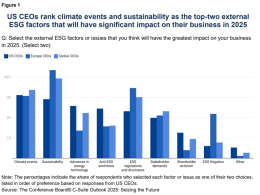At the 2024 Asia Sustainability Reporting Awards (ASRA), ASUSTeK Computer Inc. secured an impressive four accolades—including gold for both Asia’s Best Climate Reporting and Asia’s Best Environmental Impact Reporting—highlighting its leadership in sustainability reporting.
“For us, sustainability reporting is not just about disclosure—it is a strategic tool that enhances internal performance management and effectively transforms sustainability into a competitive advantage,” says Asus Co-CEO Samson Hu, setting the tone for the company’s philosophy. ASUS began publishing sustainability reports voluntarily in 2009 and now employs a layered reporting strategy, including theme-specific reports such as the TCFD and its newly launched Natural Impact Assessment Report. In this exclusive interview, Co-CEO Samson Hu and Chief Sustainability Officer TS Wu reflect on how ASUS has integrated sustainability into its business model while advancing global best practices in ESG reporting.
Why does your company publish a sustainability report?
Co-CEO Samson, Hu: ASUS publishes a sustainability report to transparently communicate our Environmental, Social, and Governance (ESG) strategy and performance to our stakeholders. This commitment to transparency and accountability is fundamental to our operations.
We voluntarily began publishing our sustainability report in 2009 and the TCFD report in 2022, both of which undergo third-party verification to ensure the accuracy and reliability of our disclosures. We began our Natural Impact Assessment Report in 2024. All of our reports adhere to international standards.
Our sustainability strategy emphasizes “Digitizing data and adopting scientific management practices”, the goal is to integrate our core competencies to build corporate sustainable value, control risks, and enhance opportunities.
Beyond general ESG reporting, we also provide theme reports to address specific stakeholder interests. Our TCFD reports and Natural Impact Assessment Report offer in-depth insights into climate-related financial disclosures and our impact on natural capital, respectively. This layered reporting strategy not only enhances external communication but also strengthens our internal performance management, driving us to integrate sustainability into our core business strategy and gain a competitive advantage.
For us, sustainability reporting is not just about disclosure—it is a strategic tool that enhances internal performance management and effectively transforms sustainability into a competitive advantage for the company.
Which part of sustainability reporting did you find to be the most challenging?
CSO TS,Wu: The evolving international sustainability reporting frameworks, such as IFRS and CSRD, present new challenges for enterprises. These frameworks not only expand disclosure boundaries but also require companies to assess the financial impact of sustainability issues. It has been challenging for ASUS to shift to a group-wide reporting scope and integrate our financial impact assessments.
To address this, in 2023 we began incorporating financial impact assessments on climate action and circular economy. We are preparing to integrate IFRS sustainability disclosures into our annual report by 2028. Through these efforts, we strive to present our performance transparently and comprehensively.
How has your company benefitted from disclosing sustainability performance?
Co-CEO Samson, Hu: By disclosing our ESG performance, we demonstrate our commitment to responsible corporate governance, ensuring that stakeholders—including clients, investors, employees, and regulators—have a clear and reliable view of our sustainability efforts. This openness not only builds trust but also aligns our company with the increasing expectations for transparency.
Sustainability reporting has also strengthened our risk management and decision-making processes internally. By systematically measuring ESG performance, we can better assess risks, identify opportunities, and integrate sustainability into our core business strategy.
Furthermore, our double materiality analysis provides deeper insights into stakeholder perspectives. Each year, we disclose progress toward our 2025 targets, transparently addressing both achievements and challenges. As a result, we foster stakeholder engagement and build corporate resilience, ensuring that sustainability remains a driving force in our corporate evolution.
What steps do you take to ensure that your sustainability report is reliable and credible?
CSO TS,Wu: To ensure the reliability and credibility of our sustainability reports, we implement a series of rigorous steps. Firstly, we strictly adhere to internationally recognized reporting frameworks such as GRI, TCFD, and TNFD. Aligning our disclosures with these standards ensures consistency, comparability, and transparency across our reports.
Internally, we’ve integrated sustainability reporting into our internal audit process. For example, our sustainability and finance teams work closely on the TCFD report to ensure all financial assessments are reliable. This collaboration showcases how we strengthen our management of sustainability data and enhance the credibility of the information we share
Additionally, we further strengthen credibility through independent third-party verification. Our sustainability report undergoes assurance at the highest level, we voluntarily comply with the AccountAbility AA1000 Assurance Standard (2008) Type II High Level, GRI Standards, and SASB. This rigorous verification process covers materiality assessments, data validation, and calculation reviews, ensuring the integrity of our disclosures.
By subjecting our reports to this level of scrutiny, we provide stakeholders with an added layer of confidence that our sustainability information is precise and trustworthy.
How do you think sustainability reporting will evolve in the next five years?
CSO TS,Wu: In the coming years, sustainability and financial reporting will become more integrated. The Corporate Sustainability Reporting Directive (CSRD) mandates the double materiality principle, requiring companies to assess both financial materiality and impact materiality. This shift ensures a more comprehensive evaluation of sustainability-related risks, opportunities, and their financial implications.
Additionally, the scope of sustainability reporting will continue to expand. Beyond corporate operations, companies will need to assess and disclose value chain impacts, particularly on Scope 3 emissions, biodiversity, and human rights. The Corporate Sustainability Due Diligence Directive (CSDDD) will further emphasize environmental and human rights due diligence, fostering sustainable and responsible corporate behaviour throughout global value chains.
As sustainability reporting evolves, its connection with financial performance will deepen, and its disclosure scope will broaden. Thus, another key development will be the application of digital platforms and systems, enabling technology-driven management practices to enhance operational efficiency and drive more structured, data-driven reporting.
What advice would you offer to other companies striving to enhance their sustainability reporting practices and earn recognition in initiatives like the Asia Sustainability Reporting Awards?
CSO TS,Wu: Exemplary sustainability reporting is more than compliance—it should balance comprehensiveness with clarity and be used as a strategic tool for driving corporate growth, fostering stakeholder trust, and positioning a company as a leader in sustainable business.
Effective sustainability reporting should articulate the company’s sustainability strategy, quantifiable goals and indicators, and provide cases to demonstrate its progress. To achieve this, companies should focus on several key areas. First, staying updated on evolving international standards and regulatory trends ensures that disclosures remain aligned with global expectations. Embracing sustainability and digital transformation enables companies to enhance data accuracy while integrating sustainability management with business operations. Also, companies should focus on enhancing transparency and accountability, ensuring that their sustainability data is verifiable. Finally, fostering meaningful stakeholder engagement through diverse channels helps build trust and demonstrates a commitment to meaningful sustainability progress. By adopting these approaches, businesses can reinforce their global leadership in sustainability.





















